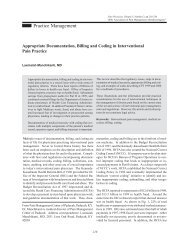ASIPP Practice Guidelines - Pain Physician
ASIPP Practice Guidelines - Pain Physician
ASIPP Practice Guidelines - Pain Physician
Create successful ePaper yourself
Turn your PDF publications into a flip-book with our unique Google optimized e-Paper software.
Manchikanti et al • <strong>ASIPP</strong> <strong>Practice</strong> <strong>Guidelines</strong><br />
53<br />
Table 10. Results of published reports on caudal epidural steroid injections<br />
Study<br />
Study<br />
Characteristics<br />
No. of<br />
Patients<br />
Drugs<br />
Utilized<br />
No. of<br />
Injections<br />
Initial Relief<br />
Control vs.<br />
Treatment<br />
Long-term Relief<br />
Control vs.<br />
Treatment<br />
3-4 Weeks (%) 3 Months (%) 6 Months (%)<br />
Breivik et al (544) P, RA, DB 35 S, LA, NS 1-3 25 vs. 63 20 vs. 50 20 vs. 50 P<br />
Bush and Hillier (545) P, RA, PC, DB 23 NS, LA, S 2 100 N/A 64 vs. 83 P<br />
Yates (549) P, RA, PC, DB 20 S, NS, LA 1-4 N/A N/A N/A P<br />
Matthews et al (546) P, RA, PC 34 S, LA 1-3 56 vs 67 SMPR N/A P<br />
Czarski (548) P, RA 183 S, LA N/A 13 vs 72 N/A N/A P<br />
Beliveau (547) P, RA 48 LA, S 1-2 70 vs. 75 70 vs. 75 N/A N<br />
Results<br />
P = prospective; RA = randomized; PC = placebo controlled; DB = double blind; LA = local anesthetic; NS = normal saline; S =<br />
steroids; SMPR = significantly more pain relief; N/A = not available; P = positive; N = negative<br />
dural injections have shown favorable response with respectable<br />
benefit (313, 317, 550-559). In 1930, Evans<br />
(313) reported a cure rate of 61% after injecting large volumes<br />
of procaine and saline to treat sciatica. The first uncontrolled<br />
study of epidural steroids with 86 patients receiving<br />
caudal epidural injections reported greater than<br />
60% relief of pain in 72% of patients (317). Mount et al<br />
(556) reported greater than 85% relief in 65% of the patients<br />
suffering with lumbar intervertebral disc syndrome.<br />
Cyriax (551) reported his extensive experience with 20,000<br />
patients, who showed significant improvement. Ciocon et<br />
al (552) studied the efficacy of caudal epidural blocks for<br />
elderly patients with lumbar canal stenosis. In this descriptive,<br />
prospective study, 30 patients with a mean age of 76<br />
+ 6.7 years with leg pain were studied, with a 10-month<br />
follow-up evaluation utilizing Roland’s five point pain rating<br />
scale. They were treated with a total of three injections<br />
of 0.5% Lidocaine with 80 mg of methylprednisolone administered<br />
at weekly intervals. The results showed significant<br />
pain reduction up to 10 months from a mean pain level<br />
of 3.4+ 0.82 to a mean level of 1.5+ 0.86, with satisfactory<br />
relief in 90% of patients. Manchikanti et al (553), in evaluating<br />
the effectiveness of caudal epidural steroid injections<br />
under fluoroscopic visualization, showed significant improvement<br />
that was better than that of blind lumbar<br />
interlaminar epidural injections. Sharma (557) studied 201<br />
patients with lumbago, sciatica, backache with sciatica, and<br />
other conditions reporting favorable results in 56% of the<br />
patients.<br />
The quality of randomized, controlled studies for caudal<br />
epidural injections is considered as high quality for four of<br />
the six studies (544-547) and of low for the two (548, 549).<br />
As shown in Table 10, the data from six of the controlled<br />
studies show positive effect in five studies. In addition,<br />
multiple systematic reviews were also favorable for caudal<br />
epidural steroid injections (45-47). Multiple observational<br />
studies also provided favorable results consistent with<br />
controlled trials. The type and strength of efficacy evidence<br />
is of level II – strong, with research-based evidence<br />
from at least one properly designed randomized controlled<br />
trial of appropriate size and high quality or multiple adequate<br />
scientific studies.<br />
Interlaminar Epidural Injections: Interlaminar epidural<br />
injections may be administered either in the cervical, thoracic,<br />
or lumbar regions. Studies in the literature evaluating<br />
the efficiency of interlaminar epidural injections, specifically<br />
the lumbar epidural injections, are extensive. This<br />
includes ten controlled studies involving lumbar epidural<br />
steroid injections (258, 560-568); but only three controlled<br />
studies involving cervical interlaminar epidural injections<br />
(569-571); along with multiple uncontrolled studies and<br />
case reports (571-612).<br />
Dilke et al (561) treated 100 patients with unilateral sciatica<br />
with either lumbar epidural injection with 80 mg of<br />
methylprednisolone and 10 mL of normal saline or an injection<br />
of 1 mL of normal saline into an interspinous ligament.<br />
All patients received physical therapy with hydrotherapy<br />
and exercise. Follow-up was at two weeks and three<br />
months, measuring time of bed rest, days of hospitalization,<br />
pain relief, consumption of analgesics, and resumption<br />
of work three months later. Sixty percent of the patients<br />
in the treated group and 31% in the control group<br />
improved immediately after the injections. A greater proportion<br />
of actively treated patients had no pain at three<br />
months, took no analgesics, resumed work, and fewer of<br />
<strong>Pain</strong> <strong>Physician</strong> Vol. 4, No. 1, 2001
















